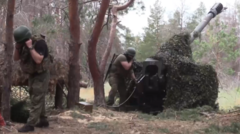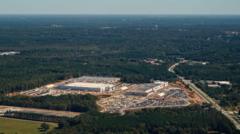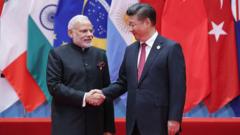Can Russia Overcome Stiff Resistance in Its Summer Offensive on Three Fronts in Ukraine?

Understanding the Current Landscape of the Ukraine Conflict: Russian Gains and Ukrainian Resilience
The ongoing conflict in Ukraine has reached critical levels, characterized by Russia's intensified drone and missile attacks coupled with its military's claims of territorial gains. As the situation evolves, the implications of these developments stretch beyond immediate military considerations, affecting regional stability and international relations. This article aims to provide a comprehensive overview of recent events, strategies employed by both sides, and the broader context of this enduring conflict.
Recent Territorial Gains: An Overview
According to open-source monitoring platforms such as DeepState, Russian forces secured a staggering 556 square kilometers (215 square miles) of territory last month. This marked the largest land acquisition for Russia in 2023, potentially reshaping the battlefield dynamics. To put this into perspective, the area gained is roughly four times the size of Liverpool and nearly equivalent to the city of Chicago.
The primary objective of Russia's military operations appears to be the disruption of supply routes utilized by Ukrainian forces, particularly in the eastern regions. By creating a buffer zone within Ukraine's northern borders, Moscow aims to fortify its territorial claims and provide a strategic advantage.
Challenges to Russian Advances
Despite these territorial claims, Russian advances are characterized by relative sluggishness. At the current pace, estimates suggest it could take over 70 years for Russia to capture the entirety of Ukraine. Such projections highlight the complexities and challenges inherent in ground operations.
Key Areas of Concentration
Russian military operations have primarily focused on three critical regions: the Sumy region, Kharkiv, and Pokrovsk. Each of these areas presents unique challenges and opportunities for both sides in the conflict.
1. The Sumy Region
In the Sumy region, Russian troops managed to push approximately 10-12 kilometers (6-7.5 miles) into Ukrainian territory. However, this advance has faced significant setbacks due to fierce resistance from Ukrainian forces. As such, the momentum of Russia's offensive has slowed considerably.
2. The Kharkiv Region
In Kharkiv, reports indicate that Russian forces have crossed the state border and captured a border village. However, without committing substantial resources, further gains seem unlikely. This stagnation suggests that Russian leadership may be weighing the costs and benefits of their operations.
3. The Strategic Hub of Pokrovsk
Pokrovsk has emerged as a critical strategic hub in eastern Ukraine. Russian forces have concentrated substantial troop numbers—approximately 111,000—around this area. However, the approach employed by Russian troops has shifted towards smaller, incremental offensives rather than large-scale assaults. This "creeping offensive" strategy aims to exhaust Ukrainian resources over time.
Casualty Reports and Human Cost of Conflict
The human cost of this protracted conflict is staggering. Ukraine's military estimates that Russia sustains over 1,000 casualties daily. While independent verification of these numbers remains challenging, they underscore the heavy toll that the conflict has exacted on both sides.
Russia's Strategic Aims in Eastern Ukraine
Military analysts assert that Russia's overarching aim in eastern Ukraine is to create a "cauldron" effect, semi-encircling Ukrainian forces in key locations such as Pokrovsk and Kostyantynivka. The goal is to force a retreat, thereby consolidating Russian territorial gains.
Operational Dynamics and Tactical Shifts
Maj Viktor Trehubov, a spokesperson for the Khortytsya operational-strategic group, notes that Russian operations are increasingly focused on wedging into the territory between Pokrovsk and Kostyantynivka. This tactical maneuver is aimed at establishing a bridgehead for further assaults. However, recent reports suggest that Russian advances in this area are already slowing down.
The Novopavlivske Direction: A New Front
One of the most significant Russian gains in recent weeks has occurred in the Novopavlivske direction, named after a village that has become a defensive stronghold following Ukrainian withdrawals. Military observers indicate that Russian forces have made notable progress, advancing up to 10 kilometers per day in this area. However, the strategic value of these gains remains debatable, as they may not translate into long-term advantages.
Ukrainian Resistance and Countermeasures
Despite the pressures on the front lines, Ukrainian forces are employing various strategies to counter Russian advances. Staff Sgt Viktor Pyasetskyi, stationed near Kostyantynivka, emphasizes the difficulties in maintaining supply routes due to persistent drone attacks. These attacks have rendered previously safe channels for delivering food, ammunition, and troop rotations nearly impossible.
The Role of Drones in Modern Warfare
Russian drones, such as the Gerbera, have emerged as formidable tools in the conflict. Capable of flying hundreds of kilometers, these drones are not just aimed at military targets but also at instilling fear within the civilian population. Staff Sgt Pyasetskyi notes that the systematic destruction of civilian infrastructure is intended to undermine morale and weaken confidence in Ukraine's defensive capabilities.
Conclusion: The Complexity of Warfare in Ukraine
The conflict in Ukraine has evolved into a complex and multi-faceted struggle characterized by shifts in strategy, human cost, and the relentless pursuit of territorial gains. As both sides adapt to the realities of modern warfare, the implications of these battles extend beyond the battlefield, influencing regional stability and international relations.
While Russia's recent territorial claims may appear significant, the challenges they face on the ground indicate that the path forward remains fraught with obstacles. As Ukraine continues to mount its resistance, the outcome of this conflict remains uncertain, leaving open the possibility for both further escalations and avenues for diplomacy.
FAQs
What are the main strategic goals of Russian forces in Ukraine?
Russian forces aim to disrupt Ukrainian supply routes, create buffer zones, and consolidate territorial gains in key regions, particularly in the east.
How has the conflict affected civilian life in Ukraine?
The ongoing conflict has severely impacted civilian infrastructure, with drone attacks leading to destruction of homes and facilities, thereby undermining morale.
What challenges do Ukrainian forces face against Russian advances?
Ukrainian forces contend with issues such as disrupted supply lines, constant drone threats, and the need to manage troop deployments effectively along a lengthy front line.
As the situation continues to develop, the question remains: How will the conflict in Ukraine evolve in the coming months, and what will it mean for global stability? #UkraineConflict #MilitaryStrategy #ModernWarfare
Published: 2025-07-09 17:32:11 | Category: technology



